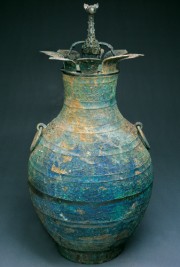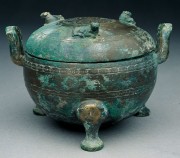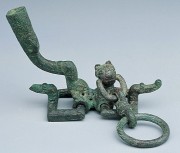The objects in this collection are excavated around the 1930s, from tomb M60 in the Liu-li-ko cemetery, Hui-hsien, Honan and tomb M1 in Shan-piao-chen, Chi-hsien. Both tombs belong to the Eastern Chou period.
Tomb M60 in the Liu-li-ko cemetery measures 5.8 m east-west by 4.7 north-south. Located at the center of cemetery, it certainly is a tomb of the ruling class with abundant accompanying burial artifacts. This tomb is dated to the Middle Spring and Autumn period (mid seventh—mid sixth century B.C.) or slightly earlier.Tomb M1 in Shan-piao-chen is the largest tomb in the cemetery, with the largest number of accompanying burial artifacts. Measuring 7.4m east-west by 7.1 north-south, it is one of the medium or large tombs of Eastern Chou. The tomb M1 dates back between the Spring and Autumn and Warring States periods, i.e., the mid fifth century B.C. or slightly later
The extravagance of these ceremonial objects tells the luxurious lives of the Eastern Chou aristocrats, and reveals the great degree of sophistication in craftsmanship and developments in the arts at this time.


|
Animal-shaped Tsun Vessel
Resource Identifier:R018596_1~3
Description:The structure of this vessel is unique. It is composed of three parts: the lotus-shaped stem, the plate, and the animal. It was unearthed with a base, but we cannot be sure that it was the base of this tsun vessel. The animal stands upright, and raises its head. The plate is roughly in the shape of a tou dish. The hollow stem has lotus petals on the top, and whorl patterns in the center.
Some thought this was a wine vessel used in sacrificial rites, but its use is still unknown.
Date:771-221 B.C.
Format:Height 12.25, length 19.0 cm.
Coverage:Tomb M1, Shan-piao-chen, Chi-hsien, Honan |
| |
|
| |
|

|
Chien Basin with Copper-inlaid Battle Scenes
Resource Identifier:R019005
Description:Two almost identical items were recovered. Each of this pair of basins has a wide mouth, flat bottom, and four animal-head handles with movable rings. These vessels are decorated with diagonal cloud-and-thunder patterns along the mouth and around the belly. They are most famous for the inlaid battle scenes, which not only show various battle scenes of ancient China, but also provide important materials for the study of the history of ancient weaponry with their depiction of the halberd, spears and two-pronged lances.
Date:771-221 B.C.
Format:Height 29.6, diameter of mouth 54.6, diameter of foot 29.6 cm.
Coverage:Tomb M1, Shan-piao-chen, Chi-hsien, Honan |
| |
|
| |
|

|
Hu Flask with Standing Bird and Flowers
Resource Identifier:R019024
Description:Two almost identical items were found. This pair of hu flasks is the finest and most original bronze hu of this tomb. The standing bird and flowers are openwork with ingenious design: the wings of the bird can be taken off, and the entire bird can also be removed from the lid. The body of the flask is inscribed with coiled dragon-like patterns, and four-leaf patterns. The pair of handles is held in the mouths of animal masks attached on the both sides of the flask.
Date:771-221 B.C.
Format:Height 60.5, diameter of belly 32.4 cm.
Coverage:Tomb M1, Shan-piao-chen, Chi-hsien, Honan |
| |
|
| |
|

|
Set of Graded Po Bells with Coiled Ch’ih Dragon Décor
Resource Identifier:R020023-020027
Description:These fourteen po bells can be divided into two groups according to their size and decoration. In the large five bells coiled ch’ih dragons were employed while interlaced snakes decorate the smaller nine bells. These two sets of graded po bells are finely made and of excellent quality.
Date:771-221 B.C.
Format:Maximum height 47.6, minimum height 32.4 cm.
Coverage:Tomb M1, Shan-pao-chen, Chi-hsien, Honan |
| |
|
| |
|

|
Sets of Graded Po Bells with Interlaced Snake Decor
Resource Identifier:R020028-020036
Description:These fourteen po bells can be divided into two groups according to their size and decoration. In the large five bells, coiled ch'ih dragons were employed while interlaced snakes decorate the smaller nine bells. These two sets of graded po bells are finely make and of excellent quality.
Date:771-221 B.C.
Format:Maximum height 30.4, minimum height 16.8 cm
Coverage:Tomb M1, Shan-pao-chen, Chi-hsien, Honan |
| |
|
| |
|

|
Ting Cauldron with Shell Decor
Resource Identifier:R020210
Description:Shell decorations appear on the lid, handles and body. The knobs of the lid are shaped into three reclining animals. Petal patterns decorate the center of the lid. Prominent casting seams are evident and soot remained at the bottom of the vessel.
Date:771-221 B.C.
Format:Height 11.6, diameter of mouth 11.2, diameter of belly 13.0 cm.
Coverage:Tomb M1, Shan-piao-chen, Chi-hsien, Honan |
| |
|
| |
|


|
Hsün Fu Ko Dagger-axe
Resource Identifier:R018737
Description:This dagger-axe has a long hu (pendant attached to the handle) with two holes. At the base of the blade, the four characters Hsün Fu chu yung ("Dagger-axe cast with the hsün fu metal") written in “bird and insect” from are inlaid with gold. On the other side is a gold inlaid character chin (or "of") written in “bird and insect” form.
Date:771-221 B.C.
Coverage:Tomb M1, Shan-piao-chen, Chi-hsien, Honan |
| |
|
| |
|

|
Chou Wang Ko Dagger-axe
Resource Type:R011841
Description:This dagger-axe has a short blade, and a broken hu (pendant attached to the handle). A section of wooden shaft remained in the ring socket. The characters "Dagger-axe used by Hsia, the King of Chou" were carved on the surface of the blade.
Date:771-221 B.C.
Coverage:Tomb M1, Shan-piao-chen, Chi-hsien, Honan |
| |
|
| |
|

|
Rings
Resource Identifier:R19702_1+R023304
Description:This piece is in the shape of an animal. Each of its two feet was linked to a square ring. One side of the square ring protrudes like a wild goose head. The mouth of the animal bites the ring; its tail becomes a wild goose. Some wood remained inside the socket. The shape of this piece is unique. The neck of the animal, the ring and the square ring can all be turned around.
Date:771-221 B.C.
Format:Length 13.5, width 4.7 cm.
Coverage:Tomb M1, Shan-piao-chen, Chi-hsien, Honan |
| |
Text and images are provided by Institute of History and Philology, Academia Sinica
Digital Resources and Archived Images Application
|






















